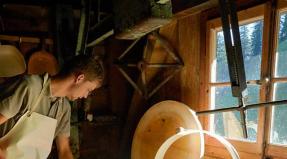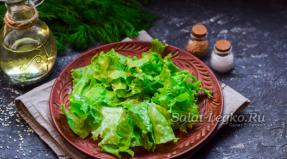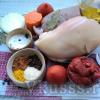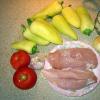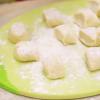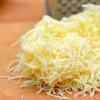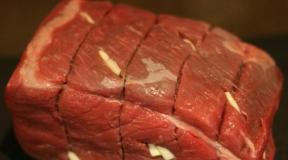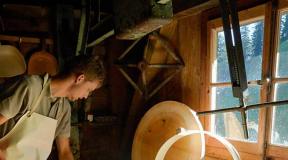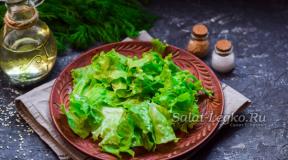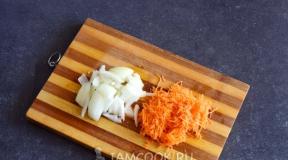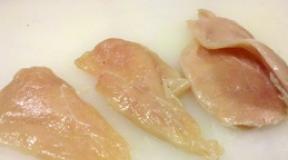Gruyère cheese: calorie content and composition, use in cooking. Description of the qualities of Gruyère cheese with photos, its beneficial properties, as well as the use of the Swiss product in recipes Cheese soup with croutons
Gruyère cheese is a traditional Swiss cheese without holes, produced in the canton of Friborg (Gruyère district). In 2001, the product received AOC status, which implies strict territorial control of its origin.
"Gruyère" can only be called a cheese produced in the district of the same name in Switzerland. In other cases, the product is prohibited from being sold under this name; it is considered a counterfeit and is punishable by the law of the country of origin.
The distinctive features of the cheese are its dense, homogeneous consistency and spicy nutty taste.
Depending on the length of aging, Gruyere can be sweet (5 months), semi-salty (8 months), salty (9 months), premium (1 year), old (one and a half years or more). It is a natural supplier of fat for energy production, proteins - building muscle, bone, cartilage tissue, potassium, magnesium - maintaining heart health, phosphorus, calcium - strengthening, regenerating bones, teeth, nails, hair, sodium - maintaining water balance within normal limits, choline – eliminates edema, normalizes levels. This type of cheese is widely used in national Swiss cuisine to create fondue and a crispy crust on casseroles.
Manufacturing technology
The history of Gruyère dates back to the 12th century. It is known that to obtain 1 kg of cheese, 12 liters of “Alpine” cow’s milk are required. It is believed that every day the masters receive 48 heads of product per bitch.
In 1992, 2002, 2005, Gruyère received the title of best cheese in the world. Currently, it is considered to be the “golden fund” of Swiss cheese making.
The head has a cylindrical configuration, reaches 9.5-12 cm in height, 55-65 cm in diameter and weighs 25-40 kg. Cheese body without eyes, hard, yellow in color, granular texture. Fat content of the product is 50%.
Le Gruyère AOP owes its excellent quality and unique taste to a unique farming method of production and careful adherence to the recipe at every stage, which is strictly controlled by cellar ripening masters, producers and cheese makers.

- Selection of high quality cow's milk. To obtain a first-class product, shepherds carefully monitor the animal feed. In summer they feed on alpine grasses, and with the arrival of cold weather they feed on greenery from local meadows. It is strictly forbidden to introduce food additives into the complementary feeding of cows. Thanks to this, milk is a valuable nutritious product that is beneficial for human health.
- Curdling. The morning milk is mixed with the evening milk, then a dairy-based milk is added to the barrel to speed up its maturation. After a while, rennet ferment, extracted from the stomachs of calves, is introduced into the raw material in order to coagulate the product. After just 40 minutes, the milk in the vat turns into a curdled compact mass (calier), which is subsequently used to make cheese. It is not boiled during the production process. Thanks to this, it retains the taste of fresh milk.
- Cutting and mixing. Calle is ground using “lira” (large knives) to obtain a curd grain. After which the contents of the vat are heated to 57 degrees. On average this takes about 45 minutes.
- Pouring into molds followed by product labeling. When the temperature reaches the required level, the cheese grain will become the size of a wheat grain. At this moment, the callier and whey concentrated in the vat are distilled into round molds on which they put a casein sign, the number of the cheese factory, the inscription “Le Gruyère AOP” and the date of production. Each head is placed for 20 hours under a press weighing 900 kg.
- Salt bath. First of all, the cheese wheels are freed from oppression and immersed in a solution with a sodium chloride concentration of 22% for a day. After 24 hours, they are taken out of the “salt bath” and placed in the cheesemaker’s cellar for storage for three months. During this time, a protective crust forms on the surface of the heads.
- Maturation in the cellar. After three months, the heads from the cheese factory are lowered into a room in which the humidity is maintained at 90% and the temperature in the range of 13-16 degrees above zero. Under these conditions, the product will ripen slowly (within 5-18 months). Caring for cheese comes down to regular turning and rubbing with saline solution.
A characteristic feature of Gruyere is the release of an ammonia odor during the ripening process.
- Quality control. By the fourth month of aging, the cheese wheels undergo strict quality control by members of the Interprofession du Gruyère association. The product goes on sale only after 5 months of ripening, provided that it meets the selection criteria.
Interestingly, the gastronomic features of Le Gruyère AOP depend on the aging period of the product. After 6-9 months, the heads emit a subtle, unobtrusive aroma and have a delicate taste. This cheese is classified as “Classique” (“Classic”). When Gruyère is stored for up to 10 months or more, it acquires a rich, complex flavor bouquet, intense aroma, and is called Le Gruyère AOP Réserve (“Reserve”).
Chemical composition
 The beneficial properties of Gruyère depend on its aging period, which starts from 5 months and can reach several years. The composition of cheese includes minerals, vitamins, proteins, milk fat, and extractives. Interestingly, the concentration of these nutrients in the product is 8-10 times higher than in milk.
The beneficial properties of Gruyère depend on its aging period, which starts from 5 months and can reach several years. The composition of cheese includes minerals, vitamins, proteins, milk fat, and extractives. Interestingly, the concentration of these nutrients in the product is 8-10 times higher than in milk.
| Name | Nutrient content per 100 g of product, mg |
|---|---|
| Vitamins | |
| 15,4 | |
| 0,562 | |
| 0,28 | |
| 0,279 | |
| 0,268 | |
| 0,106 | |
| 0,081 | |
| 0,06 | |
| 0,01 | |
| 0,0027 | |
| 0,0016 | |
| 0,0006 | |
| 1011,0 | |
| 605,0 | |
| 336,0 | |
| 81,0 | |
| 36,0 | |
| 3,9 | |
| 0,17 | |
| 0,032 | |
| 0,017 | |
| 0,0145 | |
To preserve its beneficial properties, Gruyère should be stored on the top shelf of the refrigerator, where the temperature is maintained at 5-8 degrees. To obtain maximum benefits, it is pre-heated under natural conditions before use.
Cheese should not be subjected to heat treatment, since under the influence of high temperatures it melts, which leads to changes and destruction of the protein structure and an increase in fat concentration. As a result, Gruyère, after frying or baking, loses 60% of its mineral compounds and 70% of its proteins, which reduces its nutritional value. In addition, it contains harmful cholesterol.
The product is not subject to long-term storage. After opening the sealed package, it is recommended to eat it within 5-7 days.
Remember, for good absorption, cheese should not be combined with meat, since the former contains phosphorus, and the latter – zinc. When consumed simultaneously, both nutrients participate in metabolic reactions. As a result, phosphorus slows down and partially prevents the complete absorption of zinc. The minimum interval between taking these products is 2 hours.
Benefits and harms
 Hard cheese is a source of valuable probiotic cultures, easily digestible protein, fatty acids, vitamins A, B, D, E, K, PP, macro- and microelements.
Hard cheese is a source of valuable probiotic cultures, easily digestible protein, fatty acids, vitamins A, B, D, E, K, PP, macro- and microelements.
Effect on the body:
- Slows down the aging process of the immune system, as a result, the body's resistance to infections and cancer cells increases, and the response to vaccines accelerates.
- Improves memory, digestive tract functioning, metabolic processes.
- Helps overcome depression, insomnia, and calms the nervous system.
- Gives strength and energy.
- Strengthens bones, maintains healthy teeth and joints, resists the appearance of caries, ensures normal muscle performance, and reduces the risk of developing osteoporosis.
- Increases blood pressure (useful for hypotensive patients).
- Increases hemoglobin levels.
Swiss Gruyère cheese is a product with high nutritional value (413 kcal per 100 g). It is useful in that it protects bone tissue from fractures and allows you to quickly replenish expended calories. It should be consumed by nursing mothers, pregnant women, people engaged in manual labor, children and the elderly. In addition, the product is of particular value to smokers, whose bodies lose the ability to absorb calcium due to the influence of nicotine. Swiss cheese helps alleviate some of the problem by supplying the macronutrient in large quantities.
Despite the beneficial properties of Gruyere, it is contraindicated in the following diseases: acute/chronic pyelonephritis, gastritis with high acidity, colitis, arterial hypertension, urolithiasis, cardiac edema, allergies to fermented milk products. In addition, cheese is excluded from the diet of obese people, since due to its high content it can stimulate weight gain.
Use in cooking
Gruyere is used in European cuisine for cooking, salads, sauces, casseroles, sandwiches, fondue, onion soup and baked goods (muffins, cookies). The cheese has a specific sweet-salty taste, dominated by notes of dried fruits and nuts. With age, the gastronomic bouquet becomes more tart. Thanks to its delicate taste, young “classic” Gruyère pairs well with fruity red wines.
What can replace the product?
 Italian Pecorino cheese,
Italian Pecorino cheese,
Fondue recipe
Ingredients:
- dry white wine – 200 ml;
- Gruyere cheese – 250 g;
- vodka (kirsch) – 30 ml;
- Emmental cheese – 250 g;
- lemon juice – 5 ml;
- corn flour – 30 g;
- garlic – 1 clove;
- nutmeg and ground white pepper - to taste.
Cooking principle:
- Rub the fondue container with garlic, pour in lemon juice and then sweep until hot.
- Grate the cheese and add to the prepared base. Stir the mixture periodically using a wooden spatula. This will prevent the Gruyère and Emmental from curdling, and the mixture will be lump-free.
- mix with flour until a homogeneous porridge-like mass is obtained. Add to melted cheese. Keep the dish on the fire for three minutes.
- Season with white pepper and freshly grated nutmeg, do not boil.
The finished fondue has a uniform consistency, hot and fatty.
Remember, according to the traditional recipe, the cheese dish is made from Swiss Gruyère cheese and Friborg Vacherin or Emmenthal. The main condition is to take the products in equal parts and follow the sequence of adding the products. To prevent the contents of the caquelon from sticking to the walls of the pot during cooking, use a container with a non-stick coating. If the mixture turns out to be too thick, it is diluted with wine (kirsch), if liquid, potato starch or cheese is added to the composition.
To keep the dish hot, place a gas heater or candle under the legs of the vessel.
Conclusion
Gruyere is a truly universal product that can decorate and diversify almost any dish. It is a boiled pressed cheese with a delicate sweet-salty taste and a nutty hue. It is widely used in cooking to create casseroles, muffins, pies, soups, main courses and soufflés. However, fondue is considered a traditional dish prepared from Gruyère. It is served with semi-dry Riesling. The sweet and sour taste of German alcohol complements the nutty tones of Swiss cheese well. In other cases, Gruyere is served on a cheese plate with calm whites (Flsare Tikay Pinot Gri, Chablis) or fruity red wines (Mercurey, Beaujolais, Chinon, Pinot Noir). At the same time, mature varieties are harmoniously combined with seasoned ones.
Gruyère contains all the valuable components of milk: fat, protein, mineral salts, vitamins A, E, B, K, D, which are especially important for tuberculosis patients, pregnant and lactating women, children and people with bone damage. Cheese is completely absorbed by the human body. It calms, relieves stress, normalizes blood pressure, relieves insomnia, prevents caries, strengthens the immune system, supplies energy, stimulates appetite, normalizes intestinal microflora, improves brain function.
It is recommended to eat 100-150 g of Gruyere daily. Due to the abundance of fats in the composition, it should be consumed exclusively for breakfast or lunch, since in order to digest the product in the evening (at dinner), the body will spend a lot of energy, extracting unnecessary energy before bed. As a result, this may appear on your figure in the form of weight gain. Thus, to boost energy levels, cheeses and other nutritious foods (protein products) are eaten exclusively before 14-00. In the evening, you should give preference to easily digestible, dietary dishes.
Gruyère cheese, Swiss hard yellow cheese, m.d.z. 48% dry in-ve rich in vitamins and minerals such as: vitamin A - 30.1%, vitamin B2 - 15.5%, vitamin B5 - 11.2%, vitamin B12 - 53.3%, calcium - 101.1%, phosphorus - 75 .6%, selenium - 26.4%, zinc - 32.5%
What are the benefits of Gruyère cheese, Swiss hard yellow cheese, m.d.z. 48% dry in-ve
- Vitamin A responsible for normal development, reproductive function, skin and eye health, and maintaining immunity.
- Vitamin B2 participates in redox reactions, helps to increase the color sensitivity of the visual analyzer and dark adaptation. Insufficient intake of vitamin B2 is accompanied by impaired condition of the skin, mucous membranes, and impaired light and twilight vision.
- Vitamin B5 participates in protein, fat, carbohydrate metabolism, cholesterol metabolism, the synthesis of a number of hormones, hemoglobin, promotes the absorption of amino acids and sugars in the intestines, supports the function of the adrenal cortex. A lack of pantothenic acid can lead to damage to the skin and mucous membranes.
- Vitamin B12 plays an important role in the metabolism and transformation of amino acids. Folate and vitamin B12 are interconnected vitamins that are involved in hematopoiesis. A lack of vitamin B12 leads to the development of partial or secondary folate deficiency, as well as anemia, leukopenia, and thrombocytopenia.
- Calcium is the main component of our bones, acts as a regulator of the nervous system, and is involved in muscle contraction. Calcium deficiency leads to demineralization of the spine, pelvic bones and lower extremities, increasing the risk of developing osteoporosis.
- Phosphorus takes part in many physiological processes, including energy metabolism, regulates acid-base balance, is part of phospholipids, nucleotides and nucleic acids, and is necessary for the mineralization of bones and teeth. Deficiency leads to anorexia, anemia, and rickets.
- Selenium- an essential element of the antioxidant defense system of the human body, has an immunomodulatory effect, participates in the regulation of the action of thyroid hormones. Deficiency leads to Kashin-Beck disease (osteoarthritis with multiple deformities of the joints, spine and limbs), Keshan disease (endemic myocardiopathy), and hereditary thrombasthenia.
- Zinc is part of more than 300 enzymes, participates in the processes of synthesis and breakdown of carbohydrates, proteins, fats, nucleic acids and in the regulation of the expression of a number of genes. Insufficient consumption leads to anemia, secondary immunodeficiency, liver cirrhosis, sexual dysfunction, and the presence of fetal malformations. Research in recent years has revealed the ability of high doses of zinc to disrupt the absorption of copper and thereby contribute to the development of anemia.
You can see a complete guide to the most useful products in the appendix.
"Sea buckthorn - the pantry of the Sun" This is a health library that contains the best recipes of traditional medicine, describes the healing properties of medicinal herbs and medicinal plants, reveals the secrets of medicinal folk remedies and provides recipes for herbal preparations and mixtures. A separate section of the library is dedicated. It describes the symptoms of major diseases and ailments, provides recommendations from experts on herbal treatment of various diseases and diseases, and systematizes extensive knowledge of traditional medicine, herbal medicine and herbal medicine. The most popular medicinal plants, as well as a description of vitamins, vital micro- and macroelements are highlighted in a separate section. In addition, the site contains materials used both in traditional medicine and those used in homeopathic practice. Additionally, you will be able to read on-line or on folk and alternative medicine, reference books on the beneficial and healing properties of medicinal plants, medical encyclopedic publications, advice from traditional healers, herbalists. Due to numerous requests from our readers, a section has been opened and the opportunity to rate it has been given.
Remember! Medicinal plants are not an alternative to drugs and medications. They are often classified as dietary supplements and sold through herbal pharmacies. Do not self-medicate; before using medicinal plants, be sure to consult your doctor!
The phrase “Swiss cheese” has long been entrenched in the mind as an elite, best high-quality cheese. Few cheeses can boast such high praise and recognition. Only a high-quality product, manufactured using strictly established technology and with strict control over its compliance, can be called Swiss.

What kind of cheese is that?
Such products include Gruyère cheese. Although this cheese only recently received the official name of Swiss cheese, only since 2001 has it rightfully belonged to the class of elite cheeses. It began to be produced back in the 11th century, and after another six centuries they actively returned to this issue and continued to develop the recipe. France and Switzerland fought fiercely over this cheese, proving that they were the birthplace of this elite product. In 2001, Switzerland was able to obtain AOC status, providing for strict control of the place where this cheese is made and securing a monopoly.
France produced Comté and Beaufort cheeses using the same technologies. The French and Swiss versions are distinguished by some details - small holes and a more delicate texture in French cheeses, while Gruyère should not have holes at all, it belongs to the hard class.
For its natural taste, calorie content, fat content and unusual notes, Gruyère cheese received the highest award at the cheese-making competition four times.
You can call Gruyere cheese only if it was produced in Switzerland and only in the areas of Vaud, Jura, Neuchâtel, Friborg, Bern.

Like almost all Swiss cheeses, it was named after the area where it was produced. You can argue about taste for a long time if you don’t know its features. At different times it can be sweetish, salty, salty, ripe and old. Young cheese, aged for about five months, has a sweetish taste, at eight months it has a salty taste, at nine months it has a mature, rich nutty-fruit aroma, and over 1 year old cheese has a rich and more tart taste. It is considered the most valuable, expensive and is called “Reserve” or “Top Grade”. It is classified as fatty and high-calorie.
A distinctive feature of this product is a subtle nutty-fruit aroma, which manifests itself more or less intensely at different times. Gruyère itself changes its texture over time, from softer and more delicate to denser with a richer, tart flavor. As noted above, this type of cheese can only be produced in Switzerland. Using strictly controlled technology, 1 kg of cheese is obtained from 12 liters of the best Alpine milk from those very happy cows who graze all day long in fertile meadows and eat fresh, nutrient-rich, juicy and young grass.

The manufacturing process begins with the collection of morning and evening milk, which is placed in a copper basin. A starter of lactic bacteria and rennet (an extract from the stomach of a calf containing the necessary enzymes) is added to it and this mixture is maintained at a temperature of +34 degrees until curd and whey are formed. Next, special knives are used to grind the cottage cheese to the size of a grain of rice, which subsequently gives it a unique structure and taste. Afterwards, the temperature is raised to +54 degrees and the mass is simmered until cooked, determining it by adhesion and consistency. This time according to technology is about 45 minutes.
After obtaining the required consistency, the whey is drained, and the base for the future cheese is pressed in special molds with a brand name under a load of 900 kg for about 20 hours. Next, the cheese wheels are soaked in a salt solution of 22% concentration for about a day, while the product receives approximately half of the required salt. Now you need to wait for it to ripen. It must mature in conditions as close as possible to basement conditions. After all, they are the ones who provide the cheese with its consistency, structure and taste.
Air humidity is permissible within 95–97%, temperature – +13–+14 degrees Celsius. The heads must be periodically turned over and rubbed with salt. It is at this time that a brown crust forms on the cheese. The heads are formed with a diameter of 55–65 cm, the weight of the cheese reaches 25–40 kg. Therefore, it goes on sale cut into wedge-shaped pieces.

In principle, you can consume such a product after a month, but according to the technology, you can still eat it after five months of ripening. The fact is that after five months of ripening, the young cheese undergoes strict quality control selection and only then goes on sale. Most of it is left to ripen further. The older the cheese, the fattier and higher in calories it is.
In Europe, this cheese is often used with varying degrees of ripening in the preparation of many dishes. But still, according to the recipe, real Gruyère is a hard cheese, the ripening period of which is more than one year.

Composition and calorie content
The eliteness and popularity of this cheese is determined not only by its recipe, but also by its composition. The value of this product is determined by the freshness and naturalness of the milk used in preparation. This means that all enzymes and beneficial substances are not destroyed by such heat treatment. That is, it contains milk, beneficial bacteria from milk starter, enzymes from veal stomach (rennet) and salt.
However, this cheese is quite high in calories and is considered fatty. 100 g of product contains 396 kcal, 27 g of protein, 31 g of fat, 0 g of carbohydrates, which means that you will quickly become satiated with this product.

Benefits and harms
The composition of Gruyère cheese speaks about its benefits. These are enzymes, milk fat, trace elements, minerals, vitamins A, B, D, E, K, PP. It is noteworthy that this product contains approximately 9 times more useful substances than the milk used to make it. Cheese is rich in vitamins A, P, retinol, B1, B2, B4, B5, B6, B9, B12, D, E, K. And also its constant companions are macroelements: K Ca, Mg, Na, P and microelements: zinc , phosphorus, iron, manganese, selenium, copper.
The naturalness of the product provided it with the necessary carbohydrates, replaceable and essential amino acids, saturated fatty acids and polyunsaturated fats.
Thanks to such rich content, the benefits of Gruyère cheese are obvious, such as:
- strengthens joints and bones;
- helps improve immunity;
- quickly restores the strength of the sick, elderly, athletes;
- replenishes energy reserves during physical activity;
- fights depression, insomnia, nervous conditions;
- increases the level of hemoglobin in the blood;
- fights caries, strengthens teeth;
- increases blood pressure.


Due to the high level of calcium in the product, it is indispensable for smokers, whose absorption of calcium in the body deteriorates with age. It will also be useful for lactating and pregnant women. It will help athletes recover after exercise and gain additional energy for the body. But still, not all natural products are equally beneficial for everyone.
This cheese is not recommended for people with high blood pressure, acute or chronic pyelonephritis, or those with allergies to dairy products. It is not recommended for overweight people, because it is quite fatty and high in calories.

Important! Real Gruyère cheese is produced only in Switzerland, but due to its high price (from 30 pounds per 1 kg), it rarely reaches the table of the Russian consumer. The price in stores ranges from 200 to 400 rubles per 200 grams of product.

Varieties and popular brands
The Le Gruyère Switzerland AOC Alpage variety is extremely popular. The peculiarity of this variety is that it is made only from Alpine milk from free-range cows. It is produced in small quantities and in smaller heads. The Belarusian manufacturer Postavy Gorodok took a risk and developed an analogue of the Swiss elite product. Belarusian cheeses have long been known to consumers as high-quality, natural and very tasty. And this time they used new high-tech equipment and old recipes in order to become innovators and conquer the Russian market.
Popular Russian brands did not dare to produce this cheese, because the technology is very strict, and the aging period of the cheese is long and complex. The main component in production is milk, so at the plant it undergoes strict quality control, is not pasteurized, and this ensures high similarity of the Belarusian product with the original. According to reviews of the most demanding buyers of Belarusian Gruyère cheese, it is worth noting that it has nutty and fruity notes, its consistency and structure is very similar to the original, and has the same fat content and calorie content as the original. And therefore it deservedly takes first place in customer surveys.


Use in cooking
Gruyere cheese is fatty and high in calories, which is an undeniable advantage when preparing many culinary dishes. There are many recipes using it.
Fondue
The main delicacy of the Swiss and French using this cheese is fondue. They dip bread, vegetables, gherkins, potatoes, meat and much more in processed cheese. They place any ingredient on long thin forks and dip them in hot cheese sauce. So, to prepare fondue, you will need the following ingredients:
- dry wine – 200 g;
- garlic - a few cloves;
- Gruyère cheese – 250 g;
- Emmental cheese – 250 g;
- vodka – 40 ml;
- lemon juice – 1 tablespoon;
- corn flour – 30–40 g;
- nutmeg and white pepper to taste.
Wine, lemon juice and garlic pressed through a press should be placed in a special fondue bowl and heated. Cheeses should be grated and added to the wine when it is quite hot. It is forbidden to boil. It is recommended to use a wooden spatula for stirring. You should wait until the cheese melts and then add flour mixed with vodka to the fondue. Mix everything slowly and simmer for about three minutes. At the end you need to add nutmeg and white pepper. The dish is ready.
The main thing is to maintain consistency and proportions. If the dish is still too liquid, you should add a little more flour or starch, and if it’s thick, add white wine. Cooking should be done in a non-stick pan. Fondue is served hot, so to maintain the temperature, the bowl with the cheese sauce is heated with a candle or a heating pad from below.

Cheese soup with croutons
The French consider Gruyère cheese indispensable in their classic cheese soup. It perfectly emphasizes the taste and maintains the necessary consistency. To prepare cheese soup with croutons you will need the following ingredients:
- red onion – 400 g;
- leek – 120 g;
- beef, chicken or other low-fat broth - 1 l;
- dry wine – 100 ml;
- vegetable oil – 15–20 ml;
- garlic – 1 clove;
- butter – 20 g;
- Gruyère cheese – 50 g;
- bay leaf, thyme, salt, pepper to taste;
- bread croutons.

You need to cut the red onion into thin half rings and leeks into thin strips. It is worth chopping the garlic with a knife or through a press. Thyme leaves must be torn from the stem. Pour vegetable oil into a thick-bottomed bowl and add butter to it. The fire should be small. When the butter melts, you need to add the red onion, after 5-7 minutes - the leek. And leave to simmer for about 30 minutes.
Next, you need to add garlic, thyme and wine. When the mixture warms up a little, add warm broth. Wait for it to boil, add spices and salt. After boiling, reduce the heat to low and cook for 20–25 minutes. All that remains is to get heat-resistant soup bowls, pour the soup into them, put croutons on top, sprinkle them with cheese and put them in the oven for 5-10 minutes. And that’s it, a piece of France will be in every home.

Important! Due to its excellent melting properties and strong viscousness, Gruyère cheese is often added to all kinds of pastas, seasoned with salads, baked pizzas with it, and created recipes for all kinds of casseroles. It is a frequent guest on the cheese plate due to its rich and bright taste.

Swiss Gruyère cheese and manufacturing features. Nutritional value, benefits and harms of elite fermented milk product. Recipes for dishes with it and interesting facts.
Gruyère is an elite hard cheese that is produced only by cheesemakers in Switzerland, the canton of Friborg (Gruyère district). The status of a product with controlled origin was obtained in 2001. The consistency is dense, there are practically no caverns (eyes) in the pulp. The aroma is rich, the color is yellow-cream, the taste of young cheese is sweetish-salty, with a nutty flavor; when ripened, it is slightly earthy, with a bitter taste. The older the head, the saltier it is. In Switzerland, many subspecies of the main variety are produced, but the most expensive is the Alpine variety, which is produced only in high mountain pastures.
Features of making Gruyère cheese

The main difference between this type of fermented milk product and similar ones is the special processing of the raw materials. During pasteurization, it is not heated, so beneficial compounds and enzymes do not break down.
Features of preparing Gruyère cheese:
- The initial raw materials (fresh milk from morning and evening milking) are poured into copper vats, where long-term pasteurization is carried out at a temperature of 34°C. No food additives or preservatives are introduced.
- The starter culture - calcium chloride, rennet enzymes and bacterial cultures - is placed in the same containers. The temperature is not increased. Curdling takes place within 40 minutes.
- Heating to 54-57°C is carried out only after dividing the raw material into fractions - whey and curd mass (kale). At this stage, Gruyere cheese is made like all hard cheeses - the cheese curd is cut into grains. To do this, use a special installation that resembles an immersion blender. Stir and leave at constant temperature. After 2 hours, the first tests are done - for elasticity and adhesion.
- The cheese mass is filtered and primary pressing is carried out, trying to get rid of whey. The cheese heads are formed: diameter - approximately 50 cm, weight - from 20 to 50 kg. Already at this stage marking is carried out. Bending weight (for several heads) is at least 900 kg.
- The pressed heads are soaked in brine (22%) for a day. The semi-finished product is dried at a constant temperature of 12-18°C and placed in a special storage at 14-16°C.
- A special technology has been developed for ripening Gruyère cheese. For the first 10 days, the heads are turned over up to 6-8 times a day, filled with brine, then for 14 days this procedure is repeated once every 3-4 days, then for 90 days once a week. During ripening, ammonia is released.
- After 4.5 months, a readiness test is carried out. Part of the cheese goes on sale, the rest of the product remains in storage.
The taste of Gruyère cheese varies depending on the degree of ripening: 5 months - sweet, 8 - semi-salted, 9 - salty. The elite highest grades include heads that have spent more than 12 months in storage. After 15 months, the product is popular only among connoisseurs - you can feel the bitterness.
Maturity can also be determined by the crust. In young cheeses it is golden, and then darkens and becomes dark brown.
Composition and calorie content of Gruyère cheese

The nutritional value of the product is high, so it is better to avoid adding it to your diet when losing weight. In addition, during heat treatment, the beneficial substances in the composition are destroyed, and the only benefit when consumed is a feeling of satiety.
Calorie content of Gruyère cheese is 413 kcal per 100 g, of which:
- Proteins - 29.8 g;
- Fats - 32.3 g;
- Carbohydrates - 0.4 g;
- Water - 33.19 g.
Vitamins per 100 g:
- Vitamin A - 271 mcg;
- Retinol - 0.268 mg;
- Beta Carotene - 0.033 mg;
- Vitamin B1, thiamine - 0.06 mg;
- Vitamin B2, riboflavin - 0.279 mg;
- Vitamin B4, choline - 15.4 mg;
- Vitamin B5, pantothenic acid - 0.562 mg;
- Vitamin B6, pyridoxine - 0.081 mg;
- Vitamin B9, folate - 10 mcg;
- Vitamin B12, cobalamin - 1.6 mcg;
- Vitamin D, calciferol - 0.6 mcg;
- Vitamin D3, cholecalciferol - 0.6 mcg;
- Vitamin E, alpha tocopherol - 0.28 mg;
- Vitamin K, phylloquinone - 2.7 mcg;
- Vitamin PP - 0.106 mg.
Macroelements per 100 g:
- Potassium, K - 81 mg;
- Calcium, Ca - 1011 mg;
- Magnesium, Mg - 36 mg;
- Sodium, Na - 336 mg;
- Phosphorus, Ph - 605 mg.
Microelements per 100 g:
- Iron, Fe - 0.17 mg;
- Manganese, Mn - 0.017 mg;
- Copper, Cu - 32 μg;
- Selenium, Se - 14.5 μg;
- Zinc, Zn - 3.9 mg.
Digestible carbohydrates are represented by mono- and disaccharides (sugars) - 0.36 g per 100 g.
Cholesterol in Gruyère cheese is 110 mg per 100 g.
Monounsaturated fatty acids per 100 g:
- Palmitoleic - 0.724 g;
- Oleic (omega-9) - 8.582 g.
Polyunsaturated fatty acids per 100 g:
- Linoleic acid - 1.3 g;
- Linolenic - 0.433 g.
Gruyère cheese also contains other useful organic compounds for which this product is valued:
- Leucine - necessary for the formation of muscle tissue, accelerates regeneration at the cellular level, stimulates the production of serotonin.
- Valine - it is from this acid that energy comes into the muscles.
- Glutamic acid - normalizes the acid-base balance and prevents the growth of tumors.
- Proline - improves joint mobility and flexibility of the spine; without this substance, muscular dystrophy and anemia develop, and the production of synovial fluid is impossible.
- Myristic acid - participates in lipid metabolism, stimulates the production of proteins, but can increase the level of bad cholesterol.
- Palmitic acid - it can be called a medicine for women, it stimulates the production of elastin and collagen, slows down natural aging.
- Stearic acid - protects epithelial tissues from harmful external influences.
But not only these substances are responsible for the benefits and harms of Gruyere cheese for the human body. The influence of omega-3 and omega-6 fatty acids is very important. Omega-3 lowers cholesterol levels, improves sexual function, and normalizes hormonal levels. But with its excess, the blood thins. The harmful effect neutralizes omega-6 - increases clotting, but at the same time increases the likelihood of developing heart attacks and strokes.
Useful properties of Gruyère cheese

Due to the high caloric content of the product, after consumption the feeling of satiety remains for a long time and the energy reserve is replenished. But this is not the only benefit of Gruyere cheese for the body.
Let's take a closer look at its beneficial properties:
- Increases defenses by activating the immune system and stopping the release of histamine. Introducing it into the daily menu during vaccination stops the development of allergies and helps cope with the additional epidemic load.
- It has antioxidant properties, suppresses autoimmune disorders and the formation of atypical cells.
- Like all fermented milk products, it replenishes calcium reserves in the body, which is beneficial for bone and cartilage tissue. The macronutrient is easily absorbed due to its high phosphorus content. The possibility of developing osteoporosis is reduced, and fractures are less likely to occur in old age.
- Stabilizes hemoglobin levels and prevents anemia.
- It has a beneficial effect on the functioning of the intestinal flora, normalizes metabolism, eliminates the accumulation of waste and toxins in the intestinal lumen, and eliminates bad breath.
- Aged Gruyère cheese increases blood pressure. If you are prone to hypotension due to cardiovascular diseases, a piece in the morning will quickly restore tone.
- Has a calming effect, prevents depression and nervous breakdowns. Improves mood by stimulating the production of serotonin, the hormone of pleasure.
This type of cheese can be introduced into the diet of young children, women during pregnancy and lactation, and the elderly. Recommended for people whose professional activities involve physical activity and accelerated reactions, and smokers. In the latter, calcium is quickly washed out of the body, but since this product contains especially much of it, the severity of the problem can be reduced.
Contraindications and harms of Gruyère cheese

This variety is often introduced as an ingredient in various dishes. The beneficial properties are significantly reduced after heat treatment: the structure of vitamins, minerals and protein is destroyed by 60%, and the amount of bad cholesterol increases by 65-70%.
In case of obesity, atherosclerosis in various stages, varicose veins, it is better to avoid introducing foods with this ingredient into the diet and overeating cheese in its natural form.
Gruyère cheese causes harm during exacerbation of urolithiasis, inflammatory processes of the kidneys and digestive system - pyelonephritis, colitis, gastritis with high acidity. This product should not be used if you are allergic to milk protein or have an individual intolerance.
There are no local allergic manifestations, but if after eating a piece you experience rumbling in the stomach and indigestion, it is better to turn to other types of fermented milk product.
Recipes with Gruyère cheese

Even with prolonged aging, the taste of the elite variety does not overshadow the other ingredients, but adds piquancy to the main dish. In addition, Gruyère melts quickly, so it is often used to prepare hot dishes, such as fondue or onion soup. It is often used for baking and added to salads and pasta. A cheese plate of this variety is served with Riesling, dark live beer or cider.
Recipes with Gruyère cheese:
- Champagne fondue. For production, ceramic dishes are used, which are moistened from the inside with garlic juice. Grate the main ingredient on a coarse grater - Gruyère, 450-500 g, and a piece of emmental - it should be 2 times less. Pour in 1-1.5 tbsp. l. fresh lemon juice, a glass of dry champagne, add 1 tbsp. l. potato starch. Place the bowl on the hob and stir the contents until the cheese melts, adding black pepper to taste. The finished fondue is poured onto a plate, and pieces of black bread are placed along the edges. To enhance the taste and aroma, the dish is sprinkled with champagne (60-80 ml).
- Onion soup. Finely chopped onion, 500 g, stew in a frying pan in butter until it turns light golden brown, pour in meat broth - 2 tbsp. l., leave for half an hour. White bread - 6-7 thin slices - fried. Pour 200 ml of white wine, 1 liter of broth into a frying pan with onions, bring to a boil, salt, season with grated nutmeg and pepper. The liquid is poured into deep ceramic plates. Preheat the oven to 160-180°C. Place all the plates on a baking sheet, carefully place slices of bread sprinkled with cheese on the surface of the soup and place in the oven. Once the cheese has melted, you are ready to serve.
- Quiche Lauren. It is better to use a food processor for cooking. Mix: 250 g flour, egg, 125 g butter (half a pack), a pinch of salt. The dough is wrapped in cling film and put in the refrigerator. At this time, they are preparing the filling: 250 g of bacon is cut into small cubes, blanched with boiling water in a metal colander, and then fried in butter (if the bacon is very fatty, no oil is needed). Beat 2 eggs with grated cheese - 200 g, nutmeg, salt and pepper. Preheat the oven to 200°C, grease the baking dish with oil, lay out the rolled out layer of dough, and form the sides. Bake for 15 minutes. Remove the baking sheet, pour the filling into the pie base, pour in the egg mixture and put the pie back in the oven. As soon as a golden brown crust appears on the surface, you can take it out. Serve the pie warm.
- Cheese sauce for fish dishes. First make hollandaise sauce. Separate the yolks and whites of 2 eggs, beat the yolks in a water bath, without heating them so that they are cooked, pour in 1 tsp. lemon juice, salt, pepper (it is better to use paprika or cayenne pepper). Remove the dishes from the heat, cool to room temperature, pour in melted butter - 80 g, beat until thick. Mix the milk sauce separately. Fry 50 g of flour in butter. As soon as a nutty smell appears, pour everything into a saucepan, pour in 200 ml of milk in a thin stream and lay out pieces of butter - 60 g. Stir in a water bath until thickened. The amount of flour can be increased. No salt or pepper is added. Combine 2 sauces, 100 ml each, pour in the same amount of fish broth and add 100 g of grated Gruyère. Stir until the cheese melts, and then cool, constantly whisking.
- Baked ruffins in Japanese style. 6 ruff fillets are marinated in the juice of 2 lemons, sea salt and black pepper. At this time, grate 2 parsley roots on a fine grater and fry in a frying pan along with 1.5 bunches of chopped parsley in vegetable oil. Spread the roast into an even layer, lay out the marinated fillet, a layer of tangerine slices, pour in sour cream (10 tbsp), sprinkle with grated Gruyère and bake for 20 minutes in an oven preheated to 180°C. Before serving, sprinkle with fresh dill. The best side dish for the dish is rice.

The history of this variety goes back centuries. The first producers of fermented milk products were the Romans, who shared their recipes with local peasants. Shepherds in the highlands of Switzerland, when grazing cows, did not have the opportunity to go down to the villages, so they prepared cheese for future use and left it in caves - natural refrigerators, pre-pickling it so that it would not spoil. The heads of cheese were lowered into the valley, which had already acquired a special taste, which made the variety famous.
The Count of Gruyères built his castle in this area, who, together with his relatives, established a cheese factory in 1111 and “patented” the production in 1115, publishing the charter of the cheesemakers’ guild. From that moment on, they received all the devices for making cheese from the abbey, on a special order, paying with the finished product.
By the 13th century, trade had spread to neighboring provinces and neighboring countries. In addition, we must pay tribute to the descendant of the founder of the cheese guild, Rudolf Gruyere - he allowed small producers to earn money by trading without monopolizing it.
French cheese makers made their products using a similar technology, for example, Beaufort, but the texture was more delicate and many eyes were formed. The special properties of Gruyère cheese from Switzerland are density and absolute uniformity when ripened for up to 8 months and then the initial degree of crystallization due to the high salt content.
Each province of Gruyere has its own specific gastronomic characteristics, but the main varieties are:
- Alpine (Alpage) - it comes down from the mountains in the fall, and is produced in the highlands. Cows eat only environmentally friendly raw materials - alpine grasses.
- Premium raw (Premier Cru) - its uniqueness is ensured by ripening in special climatic conditions, in the caves of Friborg.
Only varieties made in Switzerland receive the original name. The rest of the products are assigned their own names. For example, Belarusian producers have come quite close to Swiss cheesemakers in taste, having mastered the original technology. But Russian cheese makers do not use Swiss recipes for making Gruyère cheese.
Only wealthy people can enjoy elite cheese. For example, in Moscow such a product can be purchased for no less than 400 rubles. per 100 g. This price of Gruyère cheese is explained not only by the uniqueness of the technology, but also by the small yield. To obtain 1 kg of final raw material, 12-14 kg of milk are processed.
The House of Cheese, run by cousins Nicolas and Jacques Gruyères since 2004, invites visitors on a tour. You can see all the stages of preparing the product, try cutting the cheese grains yourself, and taste the under-salted semi-finished product. This trading house produces 48 heads of high-quality product per day.
How to make Gruyère cheese - watch the video:
When purchasing Gruyere, you should limit yourself to a piece that can be eaten within 5 days. This product spoils quickly, even if it is stored in the refrigerator in an airtight container, without access to air.


